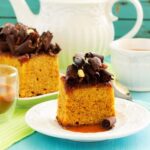Decorating a cake with fruit is not only visually stunning, but it also adds a refreshing and delicious element to your dessert. Whether you’re celebrating a special occasion or simply want to elevate your everyday baking, using fresh fruit as decoration can take your cake to the next level.
Fruit offers a burst of natural sweetness and vibrant colors that can enhance the overall taste and aesthetics of your cake. From juicy berries to tropical fruits, there are endless options to choose from, allowing you to create unique flavor combinations and visually appealing designs. Whether you prefer a classic vanilla cake adorned with strawberries or a decadent chocolate cake topped with raspberries, the possibilities are limited only by your imagination.
In this article, we will guide you through the process of decorating a cake with fruit, providing tips on selecting the perfect fruit, preparing it for decoration, and arranging it in an eye-catching way. We’ll also explore different frosting and filling options that complement the flavors of the fruit. Additionally, we’ll share creative ideas for decorating cakes with fruit in various designs and patterns to enhance its aesthetics.
So if you’re ready to add a refreshing twist to your cakes and impress your friends and family with beautiful creations, let’s dive into the wonderful world of decorating cakes with fruit.
Choosing the Perfect Cake Base
When it comes to decorating a cake with fruit, choosing the right cake base is crucial in order to enhance and complement the flavors of the fruits. Different cake flavors and textures pair differently with various types of fruits, creating unique and delicious combinations. Here are some popular choices that go well with fruit decorations:
- Vanilla Sponge Cake: The light and airy texture of a vanilla sponge cake pairs wonderfully with a variety of fruits. Its subtle sweetness allows the natural sweetness of the fruits to shine through without overpowering them. Some great fruit combinations for a vanilla sponge cake include strawberries, blueberries, peaches, and raspberries.
- Lemon Cake: The zesty and tangy flavor of lemon cake provides a refreshing contrast to the sweetness of fresh fruits. Lemon cake pairs exceptionally well with citrus fruits such as oranges, lemons, and grapefruits. Additionally, berries like raspberries or blackberries can also add a burst of brightness to a lemon-infused cake.
- Chocolate Cake: While chocolate may not be the first choice when it comes to fruit decorations, it can still create delicious flavor combinations. Rich chocolate cakes go particularly well with berries like cherries, strawberries, or raspberries that provide a tartness to balance out the richness of the chocolate.
- Almond Cake: The nuttiness and subtle sweetness of almond cakes create a delightful base for fruit decorations. Fruits such as apricots, peaches, plums, or even tropical ones like mangoes or pineapples pair beautifully with almond cakes.
| Cake Flavor | Fruit Pairings |
|---|---|
| Vanilla Sponge Cake | Strawberries, blueberries, peaches, raspberries |
| Lemon Cake | Citrus fruits (oranges, lemons, grapefruits), raspberries, blackberries |
| Chocolate Cake | Berries (cherries, strawberries, raspberries) |
| Almond Cake | Apricots, peaches, plums, mangoes, pineapples |
These are just a few examples of cake flavors that pair well with fruits. Ultimately, the choice of cake base should depend on personal preference and the specific fruits being used. Experimenting with different combinations can uncover surprising and delightful flavor profiles that will elevate any fruit-decorated cake.
Preparing the Fruit
When it comes to decorating a cake with fruit, the preparation of the fruit is just as important as the arrangement. To ensure that your fruit decorations not only look beautiful but also taste fresh and delicious, here are some tips and tricks for selecting, washing, and slicing fresh fruit.
Firstly, it’s crucial to choose ripe, seasonal fruits that are firm but not overly soft. The flavor and texture of the fruit will greatly impact the overall taste of the cake. Consider fruits like strawberries, blueberries, raspberries, kiwis, peaches, or mangoes that are vibrant in color and offer a nice balance of sweetness and tartness.
Once you have selected your fruits, proper washing is essential to remove any dirt or pesticide residues. Gently rinse the fruits under cold water and pat them dry with a clean towel. Be careful not to rub delicate fruits too vigorously as they may bruise easily.
After washing, it’s time to slice your fruits. Depending on the design or pattern you have in mind for your cake decoration, different slicing techniques can be used.
For example, if you want to create thin slices for layering or topping the cake with berries, use a sharp knife to carefully slice through the fruit vertically. If you prefer larger chunks or shapes like wedges or cubes for a more dramatic effect on your cake, adjust your slicing technique accordingly.
Remember to always handle the fruit gently while slicing to maintain its integrity and shape. Additionally, keep in mind that some fruits may oxidize quickly after being cut and exposed to air (such as apples or bananas). To prevent this browning effect while ensuring freshness and vibrant colors on your finished cake, lightly coat these fruits with lemon juice or citrus-based solutions before incorporating them into your design.
By following these tips and tricks for selecting, washing, and slicing fresh fruit, you can ensure that your cake decorations not only look visually appealing but also taste amazing. The proper preparation of the fruit will enhance the overall presentation and flavor of your cake, providing a delightful and refreshing experience for everyone who enjoys it.
Frosting or Filling Options
When it comes to decorating a cake with fruit, choosing the right frosting or filling is crucial for enhancing the flavors and highlighting the fruit decorations. The right combination can take your cake from delicious to absolutely heavenly. Here are some options to consider when deciding on the best complementary flavors:
- Buttercream Frosting: Buttercream is a classic choice that pairs well with almost any fruit. Its creamy texture and buttery flavor provide a smooth and rich base that allows the fruit’s natural sweetness to shine through. Vanilla buttercream is a versatile option, but you can also experiment with flavored variations such as lemon or almond.
- Cream Cheese Frosting: If you want a tangy and slightly tangy flavor, cream cheese frosting is an excellent choice. Its creamy consistency pairs well with fruits like berries or citrus fruits. The subtle tartness of cream cheese complements the juicy sweetness of the fruit, creating a well-balanced dessert.
- Whipped Cream: For a light and refreshing option, whipped cream is perfect for showcasing fresh fruit decorations. Its airy texture doesn’t overpower the delicate flavors of the fruit, allowing them to be the star of the show. You can sweeten whipped cream with powdered sugar or add a touch of vanilla extract for extra flavor.
- Ganache: If you’re looking for something decadent and indulgent, ganache can provide a rich chocolate complement to your fruit decorations. Dark chocolate ganache works particularly well with berries or tropical fruits like mangoes or bananas.
- Fruit Fillings: Another way to enhance your cake’s flavors is by incorporating fruit fillings between the layers. Whether it’s strawberry jam, lemon curd, or raspberry preserves, these fillings not only add moisture but also intensify the fruity taste of your cake.
Remember to consider factors like personal preferences, cake flavor, and overall balance when choosing frostings or fillings for your fruit-decorated cakes. The goal is to create a harmonious combination that highlights the natural sweetness and freshness of the fruits. Experiment with different flavors and textures to find your perfect pairing.
Basic Techniques
Step 1: Selecting the Right Fruit for Decorating
Before you start arranging fruit on your cake, it’s important to choose the right types of fruit that will not only complement the flavors of your cake but also hold up well as decorations. Opt for fruits that are firm and ripe, such as berries, grapes, kiwi, or citrus segments. These fruits have a vibrant color and can be easily sliced or arranged in a visually appealing manner.
Step 2: Washing and Preparing the Fruit
Properly washing and preparing the fruit is crucial to ensure that your cake remains fresh and hygienic. Start by rinsing the fruits under cold water to remove any dirt or impurities. For fruits with an edible skin like grapes or berries, gently pat them dry with a paper towel after washing. For fruits with tougher skins like kiwis or citrus fruits, peel off the skin using a sharp knife before slicing.
Once your fruits are washed and dried, slice them according to your desired thickness or shape. Consider using a mandoline slicer for more precise cuts. If you’re looking for uniform slices, aim for consistent widths across all pieces of fruit. Alternatively, you can create varied shapes like flower petals or wedges for an artistic touch.
Step 3: Arranging the Fruit on Your Cake
Arranging the fruit on your cake requires some careful planning to achieve a beautiful presentation. Start by ensuring that your cake is fully cooled and frosted before adding any fruit decorations. This will prevent the fruit from softening too quickly or sliding off.
Begin by placing larger slices or whole fruits around the edges of the cake to create a border. Next, fill in the center of the cake with smaller pieces or clusters of berries for an attractive contrast. You can also experiment with different arrangements such as concentric circles, diagonal lines, or even random scattering for a more eclectic look.
To ensure that the fruit stays in place, you can brush a thin layer of clear gelatin or apricot jam on top of the cake before arranging the fruit. This will act as a natural adhesive and provide added shine to your decorations.
Remember to be creative and have fun with the placement of your fruit. Allow your personal style and artistic flair to shine through as you arrange the fruits in a way that enhances the overall aesthetics of your cake.
Creative Fruit Decoration Ideas
Decorating a cake with fruit not only adds a pop of color and freshness, but it also elevates the overall aesthetics of the cake. In this section, we will explore various creative fruit decoration ideas that you can try to make your cake a truly eye-catching centerpiece.
One popular technique is creating fruit flowers on top of the cake. You can use sliced strawberries arranged in a circular pattern to create a beautiful rose-like flower. Another option is to slice kiwis into thin rounds and layer them in a spiral design to mimic the appearance of a sunflower. These fruit flowers not only look stunning but also add a burst of natural sweetness to each bite.
If you prefer a more abstract design, consider arranging different fruits in geometric shapes or patterns. For instance, you can slice oranges into rings and overlap them on top of the cake to create an intricate mandala-like pattern. Alternatively, you can carve watermelon into cubes and arrange them in an alternating checkerboard pattern for a visually striking effect.
For those who want to add some whimsy to their cake, try making fruit butterflies or ladybugs using blueberries or grapes for the body, and thin slices of strawberries or kiwis for wings. This playful touch will surely delight both children and adults alike.
Incorporating Different Fruit Types
When it comes to decorating a cake with fruit, choosing the right fruits is crucial to create not only a visually appealing cake but also one that combines flavors harmoniously. The selection of fruits can greatly depend on the theme of your cake as well as the season. In this section, we will explore different fruit types that work well with specific cake themes and seasonal variations.
For tropical-themed cakes, fruits like mangoes, pineapples, and kiwis are excellent choices. Their vibrant colors and juicy flavors bring a taste of the tropics to your dessert table. These fruits can be sliced or diced and layered on top of your cake or used as a filling between cake layers for an extra burst of flavor.
When working with citrus-flavored cakes, oranges, lemons, and limes are perfect complements. Citrus fruits provide a refreshing tanginess that balances out the sweetness of the cake. Thin slices of citrus fruits can be arranged in decorative patterns on top of the frosting or used as garnish along with some zest sprinkled over the cake for added brightness.
If you’re going for a more elegant and sophisticated look, berries such as strawberries, raspberries, blueberries, and blackberries are go-to options. These small and colorful fruits add an exquisite touch to any cake design. From layering them in between each cake tier to scattering them over buttercream frosting or even creating beautiful flower-like decorations using berries – their versatility allows for endless creative possibilities.
| Cake Theme | Best Fruits |
|---|---|
| Tropical | Mangoes, Pineapples, Kiwis |
| Citrus | Oranges, Lemons, Limes |
| Elegant/Sophisticated | Strawberries, Raspberries, Blueberries, Blackberries |
Remember that the best fruits for your cake also depend on the seasons. For example, during the summer months, watermelon and peaches are excellent choices for refreshing fruit decorations, while in the fall season, apples and pears add a cozy touch to your cake design. By considering both the theme of your cake and the seasonal availability of fruits, you can create stunning and delicious fruit decorations that will impress your guests and elevate your cake to new heights.
Enhancing the Flavor
Enhancing the flavors of a fruit-decorated cake is an essential step to take your creation to the next level. Adding extra touches such as glazes, syrups, or flavored whipped cream can complement the fruit decorations and elevate the overall taste experience. Here are some ideas on how to enhance the flavor of your fruit-decorated cake:
- Glazes: A glaze adds a glossy and flavorful finish to your cake. It can be made by combining ingredients like powdered sugar, lemon juice, and water. To incorporate a fruity twist, you can use fruit juices such as orange or strawberry instead of water in the glaze recipe. Citrus flavors work particularly well with most fruits.
- Syrups: Syrups add moisture and sweetness to your cake while infusing it with additional flavors. You can make a simple syrup by dissolving equal parts sugar and water over low heat until the sugar has completely dissolved. For fruity variations, consider incorporating extracts or concentrated fruit juices into the syrup mixture. Raspberry syrup pairs beautifully with chocolate cakes, while pineapple syrup complements tropical fruit decorations.
- Flavored Whipped Cream: Whipped cream is a classic accompaniment for cakes and can be easily flavored to enhance the overall taste of your creation. To add a twist, you can whip heavy cream with flavored extracts such as vanilla or almond extract before using it to decorate your cake with fruit. Consider using coconut extract for tropical-themed cakes or mint extract for a refreshing touch.
Adding these extra touches not only enhances the flavor but also adds visual appeal to your fruit-decorated cake. You can drizzle glazes over the top of your cake, letting them cascade down the sides for an elegant effect. Syrups can be brushed onto each layer of cake before applying frosting or used to soak individual sponge layers for added moistness and flavor depth.
Serve slices of your fruit-decorated masterpiece with a dollop of flavored whipped cream on the side or swirl it on top of each slice for an extra creamy bite. These simple additions will not only add a burst of flavor but also perfectly complement the fresh and vibrant fruit decorations on your cake.
With these extra touches, you can create a cake that is both visually stunning and tantalizing to the taste buds. Don’t be afraid to experiment with different glazes, syrups, and flavored whipped creams to find the perfect combination that enhances the flavors of your fruit-decorated cake. Enjoy the process of creating and indulging in your delicious masterpiece.
Storing and Serving Tips
After putting in the effort to decorate a cake with fruit, it is essential to properly store it to ensure its freshness and maintain the presentation of the fruit decorations. Here are some expert tips on how to store and serve fruit decorated cakes for optimal results.
Refrigeration
To preserve the freshness of a fruit decorated cake, refrigeration is key. Once the cake is fully decorated, cover it loosely with plastic wrap or place it in a cake storage container. It is important not to tightly seal the cake as it can cause condensation, which may affect the texture of the fruit or frosting. Place the cake in the refrigerator, making sure there is enough space around it to prevent any damage to the decorations.
Time Limit
The time limit for storing a fruit decorated cake depends on factors such as the freshness of the fruit used and the type of frosting/filling. Generally, a well-refrigerated fruit decorated cake can last up to three days without significantly compromising its quality. However, certain fruits like berries are more delicate and may need to be consumed within 24 hours for optimal freshness.
Serving Tips
When serving a fruit decorated cake, it is crucial to handle it carefully to prevent any damage to both the decorations and overall structure. Use a sharp knife dipped in warm water before each slice for clean cuts without smudging or dragging any frosting or fruit pieces out of place. Additionally, if your recipe calls for whipping cream or other perishable fillings, make sure they are properly chilled before serving.
By following these expert tips on storing and serving fruit decorated cakes, you can enjoy both visually stunning presentations and delicious slices of cake that are fresh, flavorful, and delightful. So go ahead and impress your family and friends with a beautifully decorated cake that is as delicious as it is visually appealing.
Conclusion
In conclusion, decorating a cake with fruit is not only a refreshing and delicious idea, but it also adds a beautiful touch to any dessert. Throughout this article, we have explored various aspects of decorating cakes with fruit, from choosing the perfect cake base to incorporating different fruit types. We have provided tips and tricks for preparing the fruit, discussed frosting and filling options, and showcased basic techniques for arranging fruit on a cake.
One of the key takeaways from this article is that selecting the right fruits for your cake is crucial. By considering seasonality and theme, you can create stunning designs and patterns that elevate the aesthetics of your cake. Additionally, enhancing the flavor with glazes, syrups, or flavored whipped cream can further complement the fruit decorations.
As you embark on your journey to decorate cakes with fruit, we encourage you to experiment and get creative. Try different combinations of fruits and flavors to find what suits your taste buds best. Remember to store your fruit decorated cakes properly to maintain their freshness and serve perfect slices.
So why not give it a try? Take inspiration from this article’s tips and techniques, gather your favorite fruits, and start decorating. Your guests will be impressed by both the visual appeal and taste of your fruit adorned creations. Enjoy the process of adding an extra touch of natural beauty to your homemade cakes.

Welcome to my blog about home and family. This blog is a place where I will share my thoughts, ideas, and experiences related to these important topics. I am a stay-at-home mom with two young children. I hope you enjoy reading it! and may find some helpful tips and ideas that will make your home and family life even better!





